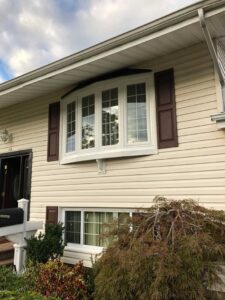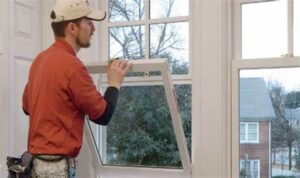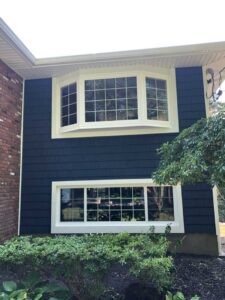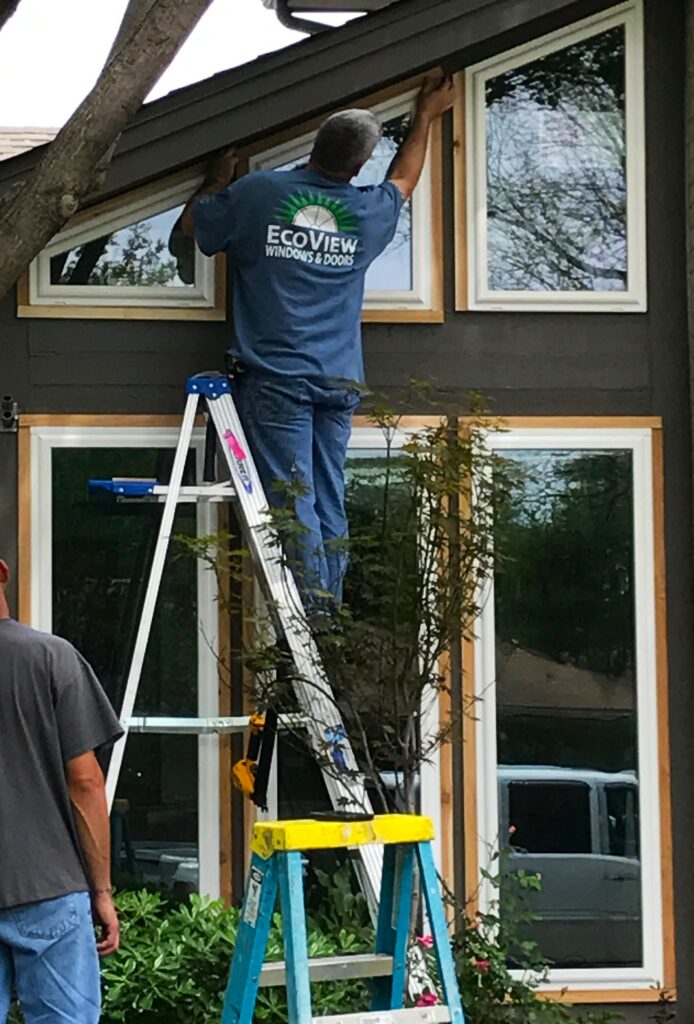When renovating or building a home, choosing the right windows can dramatically enhance both the aesthetics and functionality of your space. Bow and bay windows are popular choices that offer not only extra floor space but also flood your interiors with natural light. Whether you opt for the sweeping curve of a bow window or the more angular lines and prominence of a bay window, each type provides distinct advantages and can transform the ordinary into the extraordinary.
Understanding Bow and Bay Windows

Before choosing between a front or bay window replacement or bow window or bay window, it’s crucial to understand their unique features and how they can enhance the design and functionality of your home.
Bow Window

A bow window is characterized by its smooth, curved shape, creating a rounded appearance on the exterior of your home. This window style typically consists of four to six equally sized window panels, often either casement windows, or double-hung, which allow for ample natural light and can be operable for fresh air. The continuous curved pane of glass offers an unobstructed or unobstructed outdoor view, and lends an elegant architectural element to both modern and traditional homes.
Bay Window

Conversely, a bay window projects outward from the main walls of the building forming a bay in the room, box bay windows typically built with three windows: a large center window and two smaller windows (often either casement windows or double-hung) at an angle on either side. Bay windows create additional floor space and can include a deep sill area that serves as a display shelf or built-in window seat, perfect for enjoying the panoramic outdoor view.
Key Differences Between Bow and Bay Windows

Structure and Appearance
- Bow Windows: Offer a curved structure, creating a rounded appearance on the building’s exterior. They typically include more glass panels, providing a panoramic view.
- Bay Windows: Have a more angular structure with three main windows that create a protruding polygonal or square space. Known for their sharp angles, they often provide a bit more interior space than bow windows.
Space Requirements
- Bow Windows: Require a significant amount of wall space to accommodate their curve, making them ideal for large walls where space is not a constraint.
- Bay Windows: While still needing ample space, are more adaptable to various types of home designs due to their structured angular lines. They are perfect for creating cozy nooks, such as a breakfast nook or a dining nook.
Considerations for Choosing Between Bow and Bay Windows

Choosing the right type of window can transform the aesthetic, functionality, and energy efficiency of your home. Whether you lean towards the elegance of bow windows or the traditional appeal of bay windows, understanding the critical considerations of both bay and bow window types can help make your decision more straightforward.
Space Requirements and Installation
Bow Windows
Bow windows require a considerable amount of clear exterior wall space due to their curved design, which extends out from the exterior walls of home. Installation double hung windows is intricate, as the curved structure called compass windows demands precise engineering and framing to ensure stability and integrity.
Bay Windows
Bay windows also project outward but typically, bay windows consist of three joined windows that create a polygonal extension. They require less wall space compared to bow windows or oriel bay windows and bow windows are slightly easier to install due to their more angular structure. Bay windows are ideal for creating cozy alcoves inside the house.
Aesthetic Appeal
Bow Windows
The seamless arc of bow windows offers a unique, softening effect to the home’s exterior, enhancing its curb appeal with smooth lines and a contemporary look. They and other windows are particularly effective in modern homes where large, unobstructed glass panels can maximize views and natural light.
Bay Windows
Bay windows provide a classic aesthetic that works well with traditional and Victorian-style homes. Their angular design and capability to incorporate features like built-in window seats or breakfast nooks add character and charm to the building’s architecture.
Cost Comparison
The cost of installing bow windows is generally higher than that of bay windows. The complexity of the design and the need for additional materials and labor contribute to the higher price. However, the investment might be worthwhile for those seeking to enhance architectural beauty and panoramic views through multiple windows.
Energy Efficiency
Bow Windows
While bow windows offer stunning aesthetics, their energy efficiency can sometimes be less than that of bay windows, especially if not fitted with appropriate glazing and framing materials. Proper bow window installation with energy-efficient glass and seals is crucial to maximize their performance.
Bay Windows
Bay windows can be more energy-efficient, particularly if they use modern, energy-saving technologies like double-glazing and insulated frames. The smaller area of glass in circle bay windows relative to the frame helps reduce heat loss, making them more natural light a practical choice in colder climates.
Benefits of Energy-Efficient Windows
Both bow and bay windows offer options for energy-efficient upgrades. Benefits include reduced energy bills, lower carbon footprints, and improved indoor comfort. These windows can be customized with various types of glass and framing materials designed to enhance thermal performance and reduce UV exposure.
Design Considerations for Bay and Bow Windows

Integrating bay or bow windows into your home’s design not only enhances its architectural character but also boosts functionality. Proper planning around these three windows, can transform them from mere architectural elements to focal points of your living space.
Interior Design Around Windows
Bow Windows
Designing around bow windows involves considering their panoramic curves. Utilize their structure by setting up a seating area that complements the arc, ensuring furniture does not obstruct the view. These windows often become the room’s centerpiece, so aligning other decor elements to echo the window’s curve can create a harmonious look and more space.
Bay Windows
Bay windows are perfect for creating cozy nooks. Their angular layout makes them ideal for a reading or breakfast nook. In dining rooms or kitchens, a bay window can be strategically used to house a dining set, making use of the extra space and views offered by the extension flat front window.
Importance of Window Opening Size and Placement
The size and placement of bow or bay windows significantly affect both the interior and exterior aesthetics of your home. Larger openings full of either full bay windows, or bow window or windows can enhance natural light and views but may require structural modifications. Positioning these windows to capture scenic outdoor views or to face away from harsh weather conditions can maximize both comfort and functionality.
Window Treatments
Bow Windows
Bow windows benefit from custom curtain rods that follow their curvature, allowing drapes to draw back smoothly and showcase the picture window’s unique shape. Sheer curtains can be used over picture window to diffuse light and add softness without hiding the architectural details of picture window.
Bay Windows
For bay windows, individual shades glass panes or blinds on each pane can offer flexibility in light control and privacy. Roman shades glass panes or plantation shutters with large glass panes can also be tailored to fit each section of the bay window, providing a neat, cohesive look.
Seating and Storage Solutions
Bow and Bay Windows
Both bay window types offer excellent opportunities for built-in solutions. A custom-built window seat not only enhances the usability of bay windows extend the space but also adds additional storage underneath replacement windows. These seats can be outfitted with cushions and throws to create an inviting reading or relaxation nook.
Installation Tips for Bow and Bay Windows

Proper installation of window installations is crucial for maximizing the potential and durability of bow and bay windows. Understanding the specifics of installation can ensure optimal performance and aesthetic integration.
Preparing for Installation
Bow Windows: Preparation involves reinforcing the existing wall to support the window’s weight. Ensure compliance with local building codes and permits before starting.
Bay Windows: Check the structural capacity of the wall to handle the front bay window’s protrusion. Accurate measurements are crucial to fit the front bay window perfectly and avoid energy inefficiencies.
Common Challenges
Structural Support: Ensuring the home’s exterior walls can support the new window structure is crucial. Additional support mechanisms, such as cables or braces, might be necessary.
Weather Tightness: Achieving a perfect seal to prevent air and water leaks requires precise caulking and flashing, often demanding expertise from experienced window specialists.
Selecting the Right Window Type for Your Home
Home Layout Considerations: Choose between window styles of bow and bay windows based on your home’s layout and architectural style. Bow windows suit modern homes with their panoramic views, while bay windows fit traditional homes better, providing cozy nooks.
Replacement Considerations: When replacing windows, consider the orientation to maximize natural light and views. Opt for energy-efficient models to improve thermal performance.
Practical Tips for Installation
- Consult Professionals: Consult with a window installation specialist for advice tailored to your home’s structural needs.
- Check for Incentives: Look for tax incentives available for installing energy-efficient windows.
- Plan for Disruptions: Installation may take several days and can be intrusive. Plan accordingly to manage household expectations and reduce stress.
Pros and Cons of Bay and Bow Windows

Bay and bow windows can transform a home’s aesthetics and functionality, but choosing the right type depends on understanding their specific benefits and drawbacks.
Advantages of Choosing Bow Windows
Bow windows offer sweeping panoramic views and ample natural light, enhancing a home’s exterior wall, room’s visual space and a home’s curb appeal. Their unique curved design makes them a standout architectural feature.
Disadvantages of Bow Windows
The main drawbacks include higher costs and complex installation, as they require more exterior wall space. Also, the extensive use of glass can lead to energy efficiency challenges, though this can be mitigated with modern windows.
Pros of Installing Bay Windows
Bay windows add extra floor space and can be adapted to various architectural styles. They often feature operable panes for better ventilation and can include built-in seats or nooks, boosting both functionality and style with more space.
Cons of Bay Windows
Bay windows need careful installation to ensure structural integrity and proper weatherproofing. Their protruding design may not suit homes with limited outdoor space. While generally less costly than bow windows, the price double hung windows can increase with special features or materials.
In Conclusion
Choosing the right type of window, be it a bow or bay, can significantly enhance your home’s in Fort Walton Beach. Each style offers unique benefits and may pose challenges depending on your home’s architecture. For the best results, consulting with a window specialist is crucial. They can guide you through installation, structural considerations, and energy efficiency. Ready to upgrade your home? Contact Fort Walton Beach Windows & Door Solutions, a window specialist today to get started on enhancing your space.
